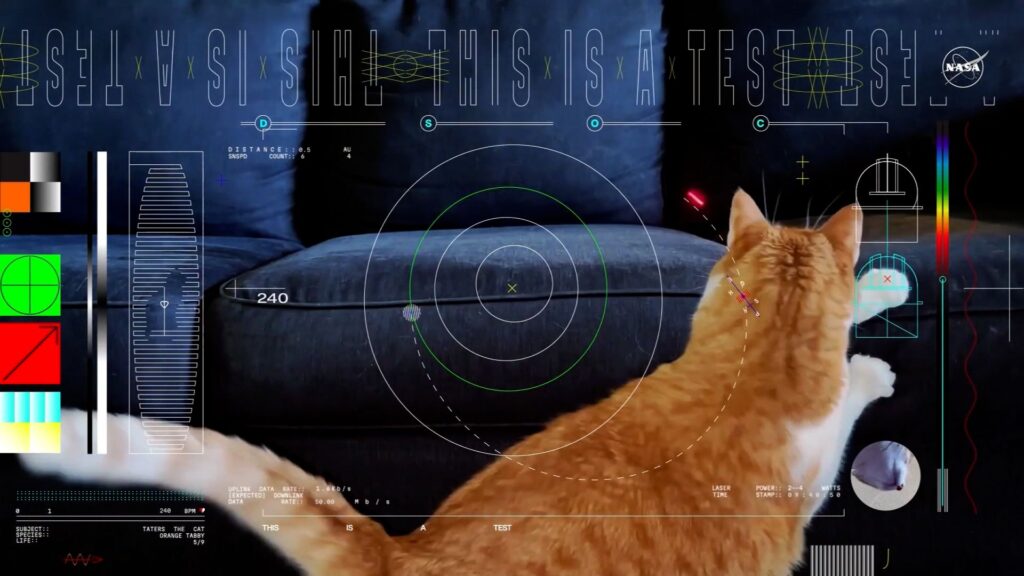An ultra-high resolution streaming video was broadcast from a record-breaking distance of 31 million kilometers, or around 80 times the Earth-Moon distance, by NASA’s Deep Space Optical Communications experiment. The accomplishment is a component of a NASA technological demonstration that aims to enable future human flights beyond Earth orbit by transmitting very high-bandwidth video and other data from deep space.
NASA Deputy Administrator Pam Melroy stated, “This accomplishment highlights our commitment to advancing optical communications as a key element to meeting our future data transmission needs.” Expanding our bandwidth will be necessary to meet our science and exploration objectives in the future, and we anticipate that this technology will continue to progress and that communication on future interplanetary missions will change significantly.
The experiment used a state-of-the-art device known as a flight laser transceiver to send the 15-second test video. Sent at the maximum bit rate of 267 megabits per second (Mbps) available on the system, the video signal took 101 seconds to arrive on Earth. With the ability to transmit and receive near-infrared communications, the device sent a near-infrared laser with an encoded signal to the Hale Telescope at Caltech’s Palomar Observatory in San Diego County, California. The telescope downloaded the signal. The footage was then sent “live” in real-time to NASA’s Jet Propulsion Laboratory in Southern California, utilizing every frame of the looping video.
Designed to transmit data from deep space at speeds 10 to 100 times greater than the state-of-the-art radio frequency systems employed by deep space missions today, the laser communications demo launched on October 13 along with NASA’s Psyche mission. The technology demonstration will send high-data-rate communications as far out as the Red Planet’s farthest distance from Earth as Psyche moves into the main asteroid belt between Mars and Jupiter. Accomplishing this opens the door for faster communications that will be able to transmit sophisticated scientific data, clear images, and videos to assist humanity’s next great leap—putting people on Mars.
Demonstrating the ability to send broadband video over vast distances is one of the objectives. According to Bill Klipstein, the project manager for the tech demo at JPL, as nothing on Psyche creates video data, we typically send packets of randomly produced test data. However, to make this momentous occasion even more unforgettable, we decided to collaborate with JPL designers to produce an entertaining film that encapsulates the demo as part of the Psyche mission.
Cat Frequency
A JPL employee’s orange tabby cat named Taters is shown in a brief high-definition video that was uploaded before to launch, chasing a laser pointer with overlaying visuals. The images depict several elements from the tech demo, including the orbital route of Psyche, the telescope dome at Palomar, and technical details regarding the laser and its data bit rate. Tater’s breed, color, and heart rate are all visible.
According to Ryan Rogalin, the project’s receiver electronics lead at JPL, it was able to broadcast the video faster than most broadband internet connections even though it was transmitted from millions of miles away. In actuality, the internet connection used to send the video to JPL after it was received at Palomar was slower than the signal from deep space. Everyone likes Taters, so JPL’s DesignLab did a fantastic job assisting us in showcasing this technology.
This most recent achievement follows the achievement of “first light” on November 14. Since then, during its weekly checkouts, the system has shown improved pointing accuracy and higher data downlink speeds. The project demonstrated downlink bit rates of 62.5 Mbps, 100 Mbps, and 267 Mbps on the evening of December 4. These bit rates are similar to broadband internet download speeds. During that period, the crew downloaded 1.3 terabits of data in total.
In contrast, throughout 1990–1994, NASA’s Magellan mission to Venus downlinked 1.2 terabits.
We were wary but thrilled to see the first light. According to Ken Andrews, JPL’s project flight operations lead, this is a new technology that we are testing.
However, we are now becoming accustomed to the system and can lock onto the spacecraft and ground terminals for longer than we could before thanks to the assistance of our Psyche colleagues. Every time we check out, we learn something new.
Additional Information About the Mission
The most recent optical communication demonstration is called Deep Space Optical Communications, and it was made possible by funding from NASA’s Space Technology Mission Directorate’s Technology Demonstration Missions (TDM) program and the agency’s Space Operations Mission Directorate’s SCaN (Space Communications and Navigation) program.
The launch service was overseen by NASA’s Launch Services Program, which is situated at the agency’s Kennedy Space Center in Florida. The spacecraft chassis with high-power solar electric propulsion was supplied by Palo Alto, California-based Maxar Technologies.
